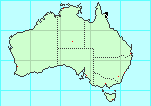Common Name:
Delete this section if there is no common name.
Identification:
Male not known.

Female 108-128 mm (type 112 mm). Female elongate,
head with a pair of spines; wingless species, brownish grey with
darker blotches; sometimes tibiae and part of tarsi darker. Whole body
irregularly covered with black granulations. Median longitudinal carina.
Head: longer than wide. Short pair of spines between eyes; spines are
variable in size. Eyes small. Several conspicuous black granulations
present. Antennae longer than fore legs. Blackish above except at base.
Basal segment much longer and broader than other segments. Thorax:
numerous granulations present dorsally and laterally; well spread and
often black tipped. Pronotum a little shorter than head with central
indentation. Mesonotum 5-7 times length of pronotum. Metanotum shorter
than mesonotum. Abdomen: slender, granulated. 8th-10th abdominal segments
short; combined length only slightly longer than 7th segment. Median
segment about one fourth length of metanotum. Anal segment subtruncate,
slightly pointed laterally (Fig. 5). Operculum broad, boat-shaped; tip
rounded, just exceeding end of anal segment. Supra-anal plate rounded
at tip, visible beneath anal segment. Cerci short, hidden beneath anal
segment. Legs: moderately long and slender, fore femora incurved basally.
All femora with pair of short apical spines. Mid and hind femora with 2-3
small subapical spines; fore femora usually with only one, but sometimes
absent. Fore tibiae slightly broadened. Hind legs almost reaching end
of abdomen. Tarsi normal except first segment of fore tarsi broadened.
(From Brock, 2000.)
 Eggs have network of large cells on capsule. There are two large
depressions, rather unusual in phasmid eggs. The conspicuous micropylar
plate is depressed into the egg, hence its shape is not quite oval.
A capitulum is present on a stalk.
(From Brock, 2000.)
Eggs have network of large cells on capsule. There are two large
depressions, rather unusual in phasmid eggs. The conspicuous micropylar
plate is depressed into the egg, hence its shape is not quite oval.
A capitulum is present on a stalk.
(From Brock, 2000.)
Habitat:
Note if the species arborial or terrestrial.
Canopy, mid, under, etc.
Note typical vegetation, e.g.
tropical rainforest, temperate rainforest,
grasslands,
alpine, etc.
Similar Species:
Rearing Notes:
From a few eggs sent to me for reference three females were reared without
difficulty on Eucalyptus gunnii in a slightly ventilated cage at
room temperature (20°C). Resulting eggs failed to hatch and this
species is therefore probably not parthenogenetic.
(From Brock, 2000.)
 Range:
Range:
NE coastal, QLD (Balderson, 1998)
Reported from north Queensland. (Brock, 2000)
Status:
It is not known if this species is endangered,
as there is insufficient sighting history.
References:
-
Balderson, J., Rentz,
D.C.F. and Roach, A.M.E. (1998).
in
Houston, W.K.K. & Wells, A. (1998) (eds)
Zoological Catalogue of Australia.
Vol. 23.
Archaeognatha, Zygentoma, Blattodea, Isoptera, Mantodea, Dermaptera,
Phasmatodea, Embioptera, Zoraptera.
Melbourne: CSIRO Publishing, Australia (ISBN 0643 06035 9).
pp. 347 - 376.
-
Brock, P.D. (2000a).
Studies on Australian stick-insects of the family
Heteronemiidae, subfamily Lonchodinae, including the description of a
new genus. Journal of Orthoptera Research, 9, Nov. 2000: pp. 51-55
-
Kirby, W.F. (1904).
A Synonymic Catalogue of Orthoptera. 8vo. Vol. 1. Orthoptera,
Euplexoptera, Cursoria, et Gressoria (Forficulidæ, Hemimeridæ,
Blattidæ, Mantidæ, Phasmidæ). London: Longmans
& Co. x 501 pp.
-
Rainbow, W.J. (1897).
Catalogue of the described Phasmidae of Australia.
Records of the Australian Museum, 3(2), 37-44.
[Note that he made a mistake re Extatosoma popa and E. tiaratum
according to
Gurney, A.B. (1947).
Notes on some remarkable Australasian walkingsticks, including a
synopsis of the Genus Extatosoma (Orthoptera: Phasmatidae).
Annals of the Entomological Society of America. 40(3): 373-396.
.]
-
Tepper, J.G.O. (1902).
List of the Described Genera and Species of the Australian and Polynesian
Phasmidæ (Spectre-Insects).
Transactions of the Royal Society of South Australia, 26: 278-287.
-
Vickery, V.R. (1983).
Catalogue of Australian stick insects (Phasmida,
Phasmatodea, Phasmatoptera, or Cheleutoptera). CSIRO
Australian Division of Entomology Technical Paper, No. 20, 15 pp.
- Search Google for
Lonchodes nigropunctatus,
or search Google Scholar for
Lonchodes nigropunctatus.
- Search Google for
Staelonchodes nigropunctatus,
or search Google Scholar for
Staelonchodes nigropunctatus.
- Search Google for
Austrocarausius nigropunctatus,
or search Google Scholar for
Austrocarausius nigropunctatus.
Synonyms:
-
Staelonchodes nigropunctatus Kirby, 1896
-
Lonchodes nigropunctatus Kirby, 1896
Copyright © 2000-2003
Peter Miller
This page was last changed 20-Sep-2006.
|

|

|


 Eggs have network of large cells on capsule. There are two large
depressions, rather unusual in phasmid eggs. The conspicuous micropylar
plate is depressed into the egg, hence its shape is not quite oval.
A capitulum is present on a stalk.
(From Brock, 2000.)
Eggs have network of large cells on capsule. There are two large
depressions, rather unusual in phasmid eggs. The conspicuous micropylar
plate is depressed into the egg, hence its shape is not quite oval.
A capitulum is present on a stalk.
(From Brock, 2000.)
 Range:
Range: 
